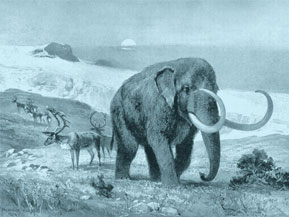
Plasma, Solar Outbursts, and the End of the Last Ice Age
15,000 to 11,000 years ago Earth experienced a series of climatic fluctuations. It had been extremely cold, with continental glaciers extending much further than they do today, but the climate started to warm. However, temperatures suddenly reverted back and there was a short cold spell, known as the Younger Dryas, before the final warming and the official end of the last ice age.
Based on Greenland ice core data, the Younger Dryas began and ended very abruptly. Its start dates to 10,900 BCE, and its ending (the final warming) began circa 9700 BCE, and may have occurred within an incredible three years; given our inability to resolve the finest details of something that happened so long ago, it may have literally happened overnight.
How do we explain this pattern of abrupt climatic shifts? I once hypothesized that comets were
responsible. A comet hitting the land or a shallow ocean, or exploding above the land's surface,
scattering dust and debris into the atmosphere, could cause global cooling. However, the evidence
does not support a comet hitting Earth at this time. I write about this in detail in Appendix 5 of
the 2nd edition of Forgotten Civilization (Did a Comet
Hit Earth at the Beginning of the Younger Dryas, circa 10,900 BCE?
). Additionally, the
following article discusses the evidence indicating that it was not a comet, but rather a massive
glacial flood (which, I would point out, could have been caused by solar activity melting ice dams
and glaciers) that changed ocean circulation patterns in the Atlantic, thus initiating the Younger
Dryas cooling:
https://www.washingtonpost.com/energy-environment/2018/07/11/scientists-may-have-solved-huge-riddle-earths-climate-past-it-doesnt-bode-well-future/?noredirect=on&utm_term=.6f7d7c278f5c.
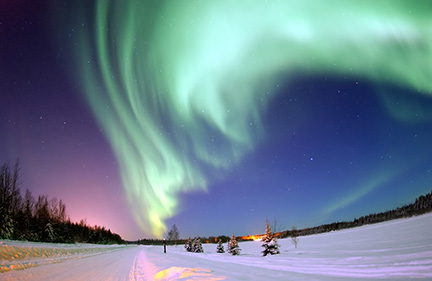
What about the warming event of circa 9700 BCE? In years past I speculated that comets hitting deep oceans were responsible. A comet might break the thin oceanic crust, releasing heat from the hot magma beneath. Vaporized and displaced water would rain down on Earth, and tsunamis would wash across coastal areas, warming the planet. But even with a comet, or a series of comets, bombarding the oceans, could the warming happen as quickly as the Greenland ice cores indicate? I think not. But if not comets, what?
Oddly, the indigenous Easter Island rongorongo script may hold the answer. But first we have to consider the concept of the fourth state of matter—plasma. Plasma consists of electrically charged particles. Familiar plasma phenomena on Earth today include lightning and auroras, the northern and southern lights, and upper atmospheric phenomena known as sprites. In the past, much more powerful plasma events sometimes took place, due to solar outbursts and coronal mass ejections (CMEs) from the Sun, or possibly emissions from other celestial objects. Powerful plasma phenomena could cause strong electrical discharges to hit Earth, burning and incinerating materials on our planet's surface. Los Alamos plasma physicist Dr. Anthony L. Peratt and his associates have established that petroglyphs found worldwide record an intense plasma event (or events) in prehistory.
Dr. Peratt determined that powerful plasma phenomena observed in the skies would take on characteristic shapes resembling humanoid figures, humans with bird heads, sets of rings or donut shapes, and writhing snakes or serpents—shapes reflected in countless ancient petroglyphs. The Easter Island rongorongo script, recorded on antique wooden tablets, is composed of similar shapes as the petroglyphs. Studying them in detail (inspired by my wife, Catherine Ulissey, who first noticed the connection), I concluded that the Easter Island rongorongo tablets (the surviving tablets are copies of copies of copies . . . .) record a major plasma event in the skies thousands of years ago. This, I believe, was the event that brought a final close to the last ice age.

Plasma hitting the surface of Earth could heat and fuse rock, incinerate flammable materials, melt ice caps, vaporize shallow bodies of water creating an extended deluge of rain, and send the climate into a warming spell. The release of pressure that follows the melting of thousands-of-meters-thick ice sheets can induce earthquakes and even cause hot rock under pressure to melt and erupt to the surface as volcanoes. The world was in chaos, and this is the event recorded by petroglyphs and the rongorongo texts.
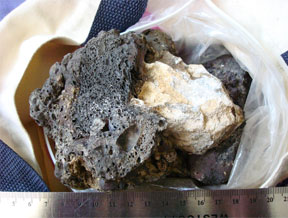
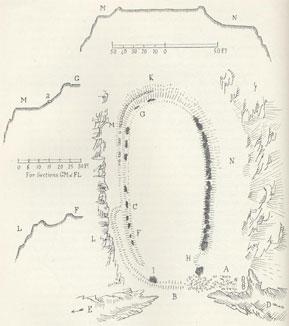
The plasma event of 9700 BCE eradicated advanced civilizations and high cultures of the time, and the radiation emanating from the plasma may have affected mental and psychical abilities. This could be the basis for the nearly universal myth of a Golden Age, a time when beings on Earth had mental abilities far surpassing those of later times. The 9700 BCE event may be the original basis for the Atlantis legends; the timeframe fits well with Plato's account.
Plasma and electrical discharges hitting the surface of Earth may have been responsible for the vitrification (melting into crude glass) of ancient stone structures seen in some parts of the world, such as various hill forts in Scotland (the accompanying photos show vitrification at an ancient Scottish hill fort, along with the ground plan of such a fort — the vitrification is shown by the dark shading). People cowered for their lives; they sought shelter in caves, under cliffs, in dwellings built of thick stone or carved into mountainsides. Perhaps Göbekli Tepe was intentionally buried in an attempt to protect it from on-going plasma events, as I suggest in my book Forgotten Civilization: New Discoveries on the Solar-Induced Dark Age. Humankind was thrown into a dark age for thousands of years, only to reemerge (amidst megalithic monuments belonging to a much earlier period) with scattered memories and nascent abilities.
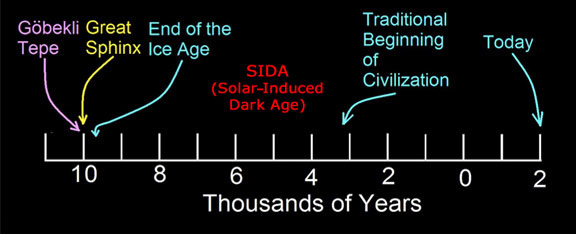
- - - - -
Banner image of the ice sheet (top of page) is courtesy of NASA.
